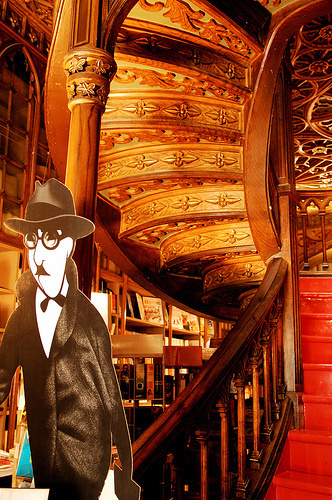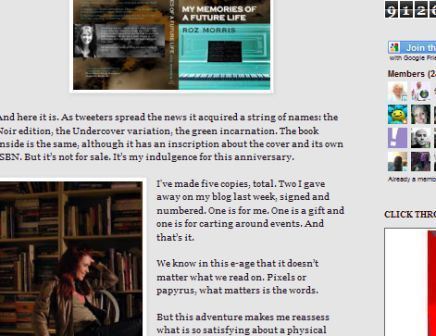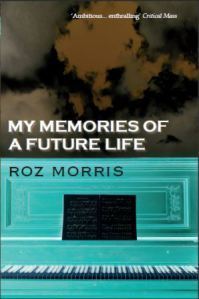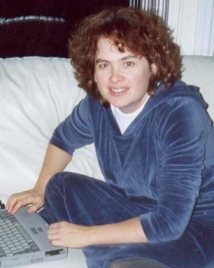Roz Morris's Blog, page 91
October 5, 2012
Nail NaNoWriMo – start now! 3 old hands share their tips
November is National Novel-Writing Month, when writers everywhere will handcuff themselves

to their keyboards and aim to get a 50,000-word draft finished in 30 days. Apart from clearing the diary and creating a big Do Not Disturb sign, what can you do to prepare?
And is it even possible?
This is a repost of a piece I ran a couple of years ago, but with NaNo rising as a buzzword again in the writerly ether, I thought it might be helpful. Tomorrow I’ll post some tips for getting your story into good shape before you start.
First of all, do established writers do this or is it just a game?
Certainly NaNoWriMo is not just an exercise. Many established writers use it to get their first drafts done. Novelist Sara Gruen wrote her New York Times #1 bestseller Water For Elephants one NaNoWriMo. What you start in NaNo can go on to great things – here’s a list of all the NaNo novels that have made it into print.
How do you do it?
I’ve never done NaNoWriMo because other projects have got in the way, but I have written a lot of novels to tight deadlines – 50,000 words in two months. And not just first draft, but revised and ready for a publisher to see. It was effectively two NaNoWriMos back to back, which I did several times.
I have several friends who are NaNoWriMo winners. Here are their tips. And the key to success is not just what you do in November, but what you do NOW.
Prepare your story
Zelah Meyer is a NaNoWriMo powerhouse, having consistently delivered 50,000 words for the last five years. Some years, she even lost a week because real life inconveniently got in the way, but even so, she sailed past the finish line. This year she’s hoping to finish the first draft of her trilogy.
 Zelah (left) says: ‘Do a rough brainstorm beforehand of where you want to take at least the first 5,000 words or so. I call it plot scaffolding and I’ll often talk to myself on paper about what could happen and where the story could go. I find it helps to know that so that I can avoid writing myself into a corner – but everybody works differently!
Zelah (left) says: ‘Do a rough brainstorm beforehand of where you want to take at least the first 5,000 words or so. I call it plot scaffolding and I’ll often talk to myself on paper about what could happen and where the story could go. I find it helps to know that so that I can avoid writing myself into a corner – but everybody works differently!
‘I ask myself a lot of questions such as “Why does nobody know that he isn’t really the lost prince/company CEO/etc?” I use the ideas I have to flesh out character back story and sometimes that will give me ideas for the plot.
‘If I decide that I need to go back and add in a scene, I’ll do that – but I never rewrite one. Instead I have a second document that I keep open called Corrections. There I make notes of changes I want to make in the re-writes and then continue as if I’d already done them.
‘I also find it helps to have a third document for any names I need to keep track of. This saves me from wasting ages scanning back through thousands of words trying to find out which town the characters were heading for or what you called the hero’s aunt.’
In real life, Zelah is an improvisational performer, and her experiences on stage have strengthened her approach to storytelling. ‘I ask myself: “If I were in the audience, where would I want the action to go now?” and “Which character do I want to hear from now?” Also, everything that is said changes you – both the person saying and the person listening. Everything evokes some kind of emotional response and that colours how things happen from then on.’
Prepare your t argets
argets
Gareth Ryder-Hanrahan (left), another NaNoWriMo veteran, says: ‘My one tip is stick to your daily wordcount no matter what – 1,600 words a day even if you’ve been run over by a steamroller. Nothing’s more disheartening than an impossible deadline,’
Zelah’s keen on statistics too. ‘I create a spreadsheet for the 30 days of November with how many words I aim to write on each day. I give myself a contingency of around 5,000 words.’
Prepare your research
If you go and look something up on Google, do you stop there? No; an hour later you can still be happily cyber-faffing. So do all your Googling, Wiki-ing and forum fact-finding before November. Don’t burn through your writing time by looking stuff up. If necessary, put a keyword in the text like [factcheck] and start a file for queries you will Google in December.
You don’t slog through NaNoWriMo on your own. That’s one of the beauties of it. The NaNoWriMo website is, of course, essential, and you’ll find hashtag communities on Twitter, and bloggers who will be wearing NaNo badges and blogging if they have any fingers to spare.
Ann Marie Gamble, another old hand, says: ‘The single best non-official resource I used was Doyce Testerman’s day-by-day blog posts. He described exactly what he was going through so I could think, ah, everyone feels like they are choking on Day 11 – it’s not just me being pathetic. Plus he has a wife and kid, so his coping strategies are more accessible to me than those of the college students in the local NaNoWriMo groups.’
Remember it’s a first draft
NaNoWriMo is about turning off your inner editor. If your draft sucks that doesn’t matter. All first drafts suck.
It is also about a definite goal. Ann Marie says: ‘Keep your eyes on your prize. NaNoWriMo is a chance to build writing habits and experience in finishing a piece. Don’t get sidetracked by questions of quality, plausibility, readability etc. Let your pen fly during this intense month and analyse later.’
Zelah says: ‘When I’m actually working, I remind myself that I’m not striving for perfection at this stage. I have a strip of paper saying “Quantity not Quality” taped to my monitor.
The message is, prepare, prepare, prepare.
your story
your research
your targets
your support groups
And that, my friends, is why NaNoWriMo starts now.
 With all that sorted, just one thing remains. Simon C Larter (left) of the blog Constant Revisions says: ‘How do I convince my wife it’s okay for me to spend so much time writing?’
With all that sorted, just one thing remains. Simon C Larter (left) of the blog Constant Revisions says: ‘How do I convince my wife it’s okay for me to spend so much time writing?’
Are you doing NaNoWriMo? How are you preparing? Is it your first time? If you’ve done it before, do you have any tips? And if NaNo requires you to ramp up your writing routine, how, like Simon, will you convince your nearest and dearest to indulge you? Share in the comments
You can find tips for researching, outlining and what makes a robust story in my book, Nail Your Novel – Why Writers Abandon Books and How You Can Draft, Fix and Finish With Confidence. Available on Kindle and in print. And tomorrow I’ll be going through a workup routine to get your story sorted before you lock the doors.


October 2, 2012
‘Dark bars, blazing sun and volatile people’ – The Undercover Soundtrack, Erika Robuck
 My guest this week says music helped her slip away from 21st century family life into the volatile, simmering Key West of 1935. Her novel features a half-Cuban woman who goes to work for Ernest Hemingway (who himself once said he used words the way that Bach used notes). She is Erika Robuck and she’s on the Red Blog talking about the Undercover Soundtrack for Hemingway’s Girl.
My guest this week says music helped her slip away from 21st century family life into the volatile, simmering Key West of 1935. Her novel features a half-Cuban woman who goes to work for Ernest Hemingway (who himself once said he used words the way that Bach used notes). She is Erika Robuck and she’s on the Red Blog talking about the Undercover Soundtrack for Hemingway’s Girl.


September 30, 2012
Strangers in my photos – writing prompt and tip for developing a story’s world
 Who’s that lady with the handbag, sneaking out of shot while Dave was taking a picture of me at the Bluebell Railway museum?
Who’s that lady with the handbag, sneaking out of shot while Dave was taking a picture of me at the Bluebell Railway museum?
The strangers in our photos are the people we aren’t meant to notice. People we tune out. I never gave them a thought until I read about the British artist Polly Morgan, who, when she was a kid, went through family photos, cut out the walk-ons and made a gallery of them on her bedroom wall.
I love this idea. All these anonymous people, abundant as traffic and trees, appearing accidentally in our private photos.
Who were they? While Dave and I walked around the museum, the lady with the handbag was on her own mission. She had a chain of events that brought her to this place and she went on to do something else afterwards. What was it?
A lot of writers talk about the inspiration they get from overhearing conversations, but it seems to me that a picture is worth a thousand eavesdropped words. And our photo collections are full of them. The person you didn’t intend to take a picture of is waiting to have their story told.
This is a fun exercise on its own but it can also be useful for our novels. When we’re writing, we often find we have gaps in our story world. Sometimes we need a ‘purposeful nothing’ for a character to do when they go for a think, or a route they can take to the gym or work. Insignificant, low-key stuff, but if it’s not there the world of the story doesn’t feel real. The characters live in a void like an undecorated film set.
 In daily life, we get used to tuning things out, which is perhaps why writers have to make a special effort to flesh out a world. Who’s that in the distance, sitting on a bench in a square in Fontainebleau, while I’m taking a photo of Dave? Did she need to think of a place to meet her best friend for a heart to heart?
In daily life, we get used to tuning things out, which is perhaps why writers have to make a special effort to flesh out a world. Who’s that in the distance, sitting on a bench in a square in Fontainebleau, while I’m taking a photo of Dave? Did she need to think of a place to meet her best friend for a heart to heart?
So I’m ending this post with an exercise. Either tell me how you find insignificant but useful locations, or write a little piece about the strangers in the pictures here. Or do this with a pic of your own on your blog, link to it here – and we’ll all come and see. (That’s a blog hop, isn’t it? Never done one before.) Let the fun begin…


September 25, 2012
‘I love to play with grey areas in my fiction’ – The Undercover Soundtrack, Niki Valentine
 My guest this week set her psychological thriller in a music conservatoire. Two pieces of music brought the book to life for her – a Schubert song with a beguilingly vulnerable female vocal, and a Rachmaninov sonata that turned out to have an illuminating link with Goethe’s Faust. She is Niki Valentine and she’s on the Red Blog today talking about the Undercover Soundtrack to her novel Possessed.
My guest this week set her psychological thriller in a music conservatoire. Two pieces of music brought the book to life for her – a Schubert song with a beguilingly vulnerable female vocal, and a Rachmaninov sonata that turned out to have an illuminating link with Goethe’s Faust. She is Niki Valentine and she’s on the Red Blog today talking about the Undercover Soundtrack to her novel Possessed.


September 23, 2012
Literary versus genre fiction – what’s the difference?
 How do you define literary fiction?
How do you define literary fiction?
Is it the writing? Do literary novels do it better than genre novels? You’d certainly expect them to, and it’s true that some writers of genre have a tin ear. Equally, many genre writers are terrific wordsmiths – Ian Fleming, Thomas Harris. Anyway the best writing suits the job – whatever that job is.
Is it insight? You definitely can’t have literary fiction without it. Although some genre writers get close. Is John Le Carre a spy novelist or a literary writer?
Is it that literary fiction doesn’t follow rules?
With a genre novel, tropes must be respected because they are what the reader enjoys. A family saga must run a well defined gamut of black sheep, poor relations, blissful marriages and disastrous elopements because otherwise the reader feels that the writer missed the obvious opportunities. The entertainment is in how these obligations are met in a fresh way, the individual writer’s ingenuity within this formal structure.
If genre authors bust out of their boxes, they risk disappointing their readers. Ruth Rendell, who you’d think has a reliably adoring fan base, was careful to adopt a different name to explore beyond conventional crime fiction. When Iain Banks wrote sci-fi as well as lit fic, he stuck an M between his names. But then some writers jump categories and face their public with no disguise – Robert Harris with his modern thrillers and historical fiction. Perhaps it all comes down to how hard he can argue with his publisher.
 If rules, or the lack of them, are the crucial difference, does that make genre benders literary? Maybe, if the blend creates a provocative and resonating tension. But sometimes fusing genres is no more than a simple exercise of this-meets-that (or adding freshly boiled zombies).
If rules, or the lack of them, are the crucial difference, does that make genre benders literary? Maybe, if the blend creates a provocative and resonating tension. But sometimes fusing genres is no more than a simple exercise of this-meets-that (or adding freshly boiled zombies).
If a literary novelist writes about a murder, they certainly don’t have to meet the expectations that a crime novelist or detective writer would – think of Donna Tartt’s The Secret History. If genre is about the reader’s expectations, perhaps literary is an anti-genre.
Let’s take Woody Allen as an example. Yes, his medium is celluloid, but it all starts with words and pages. His body of work includes character pieces (Annie Hall, Vicky Christina Barcelona), madcap sci-fi comedies (Sleeper), cosy mystery spoofs (Manhattan Murder Mystery) bleak examinations of morality (Crimes And Misdemeanours). Sometimes, but not all the time, he breaks the bounds of reality by adding time travel (Midnight in Paris), fantasy (The Purple Rose of Cairo). Or singing, flying and ghosts in Everyone Says I Love You. In his latest, To Rome With Love, a character turns invisible.
With Allen, you never know what rules will be followed – and yet you do. They are Allen’s rules, created by his own themes, obsessions and humanity. They’re what we come back for.
So perhaps each literary writer creates a genre of their own, invents the colours they paint in. Like with genre fiction, it makes its own expectations. Perhaps the two are not so very different.
Thanks for the pic pedrosimoes7
What do you think? Is ‘literary’ a genre? What makes a writer literary? What makes them not? Are there any writers you’d say were both genre and literary?


September 19, 2012
Eezer goode… but print is proper – post at Authors Electric
 (If you’re not a Shamen fan, that headline will make no sense. Try saying it out loud. And admire your instant cockney accent.) Making the special print edition of my novel made me think how we still like a book we can get our hands around. Come over to Authors Electric where I’m trying to pinpoint what we love about dead tree books…
(If you’re not a Shamen fan, that headline will make no sense. Try saying it out loud. And admire your instant cockney accent.) Making the special print edition of my novel made me think how we still like a book we can get our hands around. Come over to Authors Electric where I’m trying to pinpoint what we love about dead tree books…

September 18, 2012
‘The song epitomised Titanic, its beauty and its loss’ – Ellie Stevenson, The Undercover Soundtrack
 My guest this week has a haunting tale with two timelines, one in the present and one aboard the magnificently doomed RMS Titanic. She first had the idea from a water effect in a Madonna album track, and when research turned up a song in the White Star Line orchestra repertoire, that piece became a signature for the characters and their loss. She is Ellie Stevenson and she’s on the Red Blog talking about the Undercover Soundtrack for Ship of Haunts: The Other Titanic Story.
My guest this week has a haunting tale with two timelines, one in the present and one aboard the magnificently doomed RMS Titanic. She first had the idea from a water effect in a Madonna album track, and when research turned up a song in the White Star Line orchestra repertoire, that piece became a signature for the characters and their loss. She is Ellie Stevenson and she’s on the Red Blog talking about the Undercover Soundtrack for Ship of Haunts: The Other Titanic Story.

September 16, 2012
Got to explain my story’s world… but how do I avoid exposition?
 I have a client who has written an ambitious novel set in a dystopia. It’s a powerful idea, but he hadn’t made me understand the world. I was constantly confused about what the characters were doing and why the scenes he showed me were significant.
I have a client who has written an ambitious novel set in a dystopia. It’s a powerful idea, but he hadn’t made me understand the world. I was constantly confused about what the characters were doing and why the scenes he showed me were significant.
He explained he was trying to avoid exposition – for which he gets a stack of brownie points, if not actual brownies. But how should he fill the gaps?
Don’t even mention ‘prologue’
Neither of us even uttered the words ‘explanatory prologue’. I’m saying them here for the sake of completeness. A prologue describing the world is not, generally, a good way to captivate a reader. They want to plunge into the story and bond with characters, not sit down for a lecture.
What’s exposition?
Exposition is when the author tells the reader something they need to understand and is obvious about it. So a pair of characters natter about a subject they don’t need to talk about. ‘I have to go and clean the neutron drive, Susan. As you know, we’re on a big spaceship and have been for many months.’ Unless the line is to show an ironic character quirk, this is the author shoving his face between the characters.
Opposite of TMI
But if you give the reader too little context, they don’t know where they are or what anything means to the characters. Yours truly, Baffled.
Let me explain
The only sin of exposition is that it is unnatural. So you find ways to slip this material in without breaking the fourth wall.
If the world is new to the character, like Harry Potter’s entrance to Hogwarts, your task is simple. Get the reader curious, then show them all the mad stuff. But if the world isn’t new to the character, you have to be more subtle.
 Here’s how George Orwell does it in Nineteen Eighty-Four.
Here’s how George Orwell does it in Nineteen Eighty-Four.
He begins with a tour of Winston Smith’s ordinary life. We have a day in April (relatable, familiar) and clocks striking thirteen (borderline normal, and strange enough to intrigue us). Winston is hurrying along in the wind to his grotty apartment block (normal). The lift is out of order (relatable) because of Hate Week (crikey, what’s that?). There’s a poster: ‘Big Brother is Watching You’ (intriguing and sinister). Inside his mostly familiar apartment is a telescreen, which he can’t turn off (weird). Outside his window there’s a sign in a distorted form of English (skewed and forbidding). He tries to find a place where the screen can’t see him (exactly as we might, because it isn’t nice being watched). Why is he hiding? To do something we take for granted – he is writing in a diary.
This sequence is explaining the world but it’s totally natural. (Historical novelists have to do it too.) It’s showing a piece of life that we would recognise, and intriguing us with what’s distorted. Even better, Orwell has added the character’s need: privacy to be himself. Because a world isn’t about things, it’s about people.
Information, information
At any time in a story, we might have to convey lumps of information that the characters know but the readers don’t – for instance, what spelunking is, how a horseshoe is made. Explaining a world is no different.
Exposition is simply when you do it badly.
Let’s have some more examples of authors who explain their characters’ worlds with style – share in the comments!
 COMPETITION WINNERS If you get this blog by email, you might have had trouble with the post I whipped up first thing announcing the winners of the Future Life special edition. I loused up the link to the Red Blog – it should have been this. Doh. Scoot to the bottom of the post for the results. And note to self: medicate with coffee before hitting publish.
COMPETITION WINNERS If you get this blog by email, you might have had trouble with the post I whipped up first thing announcing the winners of the Future Life special edition. I loused up the link to the Red Blog – it should have been this. Doh. Scoot to the bottom of the post for the results. And note to self: medicate with coffee before hitting publish.

Who’s won the noir edition?

 Did you enter the competition to win the limited not-for-sale copper-and-thunder edition of My Memories of a Future Life? The entries have been shaken, stirred and stuffed into a fancy box. The winners are… at the bottom of the post on the Red Blog now…
Did you enter the competition to win the limited not-for-sale copper-and-thunder edition of My Memories of a Future Life? The entries have been shaken, stirred and stuffed into a fancy box. The winners are… at the bottom of the post on the Red Blog now…
Proper writing post (on exposition) follows later today!

September 12, 2012
‘Music, the language of souls’: The Undercover Soundtrack, Roz Morris – and WIN a limited print edition of the novel
 With a red piano on the cover, you can bet my novel has a well-stocked soundtrack. I listened to Grieg’s piano concerto in A so often that I developed absolute pitch. The harmony – or counterpoint – between the two narrative lines began in a piece by Joe Jackson. Andreq’s composure came from an exquisite singer whose song titles alone make me want to write. It’s my turn on the Red Blog today, talking about the Undercover Soundtrack for My Memories of a Future Life.
With a red piano on the cover, you can bet my novel has a well-stocked soundtrack. I listened to Grieg’s piano concerto in A so often that I developed absolute pitch. The harmony – or counterpoint – between the two narrative lines began in a piece by Joe Jackson. Andreq’s composure came from an exquisite singer whose song titles alone make me want to write. It’s my turn on the Red Blog today, talking about the Undercover Soundtrack for My Memories of a Future Life.
And to conclude the anniversary festivities (which means you have a proper writing post this weekend) we have a…
COMPETITION Win a very limited print edition of My Memories of a Future Life
 Alternative album sleeves are de rigeur in music, so I thought I’d try it in books. Voila – the Undercover variation.
Alternative album sleeves are de rigeur in music, so I thought I’d try it in books. Voila – the Undercover variation.
This edition isn’t for sale, it’s simply something I wanted to make. But you could win one of two copies – signed and numbered – by commenting on my Undercover Soundtrack. Earn even more karma by sharing around the etherverse (both now and in the future). Find out more….





